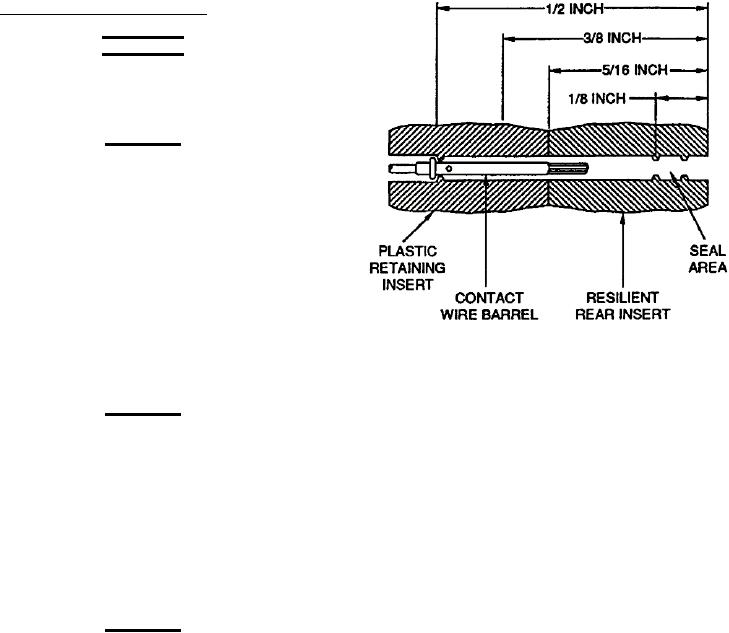
NAVAIR 01-1A-505-2
008 02
TO 00-25-255-1
Page 32
TM 1-1500-323-24-2
105. Broken Wire Contact Removal.
WARNING
Metal tool tips are sharp and can cause injury
to personnel and/or damage to connectors.
CAUTION
Present metal tooling in some instances has
damaged the wire sealing grommet at the end
of the connectors. Plastic tools are preferred.
Caution should be exercised in the use of
tooling.
Inspect tips of metal tools for nicks, burrs, and
distortion of probe before use as connector
damage can occur.
Figure 25. Typical Connector Dimensions
a.
Select correct removal tool (Table 5).
c.
Gently insert removal tool into cavity in about
CAUTION
1
is felt.
Removal of a contact with a broken wire shall
not be attempted with an unwired removal
NOTE
tool. Use of unwired removal tools require that
the tip be jammed onto the contact wire barrel.
Rotating removal tool works splayed wire
If wire strands occupy wire barrel, the tool and
strands into slot of tool, allowing tool to pass.
connector may be damaged.
Removal tool may be blocked at rear of contact
b. Insert tip of removal tool about 1/8 inch into
by plastic insert or additional strands of broken
cavity at rear of connector.
wire.
CAUTION
d. If resistance is felt before removal tool reaches
back end of contact, withdraw tool slightly, rotate
Wire strands may be encountered at any point
about 1/6 of a turn, and reinsert tool. Repeat rotating and
up to 5/16 inch of tool insertion. It is important
insertion procedure until tool passes with minimum
not to jam any strands of wire up to this point.
additional force to 5/16 inch depth back end of contact
(Figure 26).
Withdraw removal tool anytime during
insertion when it cannot be advanced into
e.
Wiggle removal tool gently to help it into
connector using these procedures. Inspect tool
insert bore and over back of contact. Additional rotation
tip for nicks, cracks, mushrooming, and other
may be required if broken strands are encountered.
damage that will prevent its functioning.
Replace removal tool and repeat procedure, if
f.
Continue insertion of removal tool until
required.
positive stop is felt at about 1/2 inch depth.
NOTE
g. Exert axial pressure on engaging end of contact,
using appropriate pin or socket as pushed. (If contact
Refer to Figure 25 for approximate dimensions
does not move, seat removal tool more firmly).
of a size 22 contact and cavity. The dimensions
in this procedure are based on a size 22 contact.
h. Push contact completely out rear of connector
before disengaging removal tool (Figure 27).

